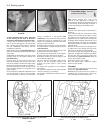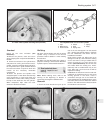
contact the brake pads or disc. Also refer
to the warning at the start of Section 2
concerning the dangers of hydraulic fluid.
1 Chock the front wheels then jack up the
rear of the car and support it on axle stands
(see “Jacking and vehicle support”). Remove
the rear roadwheels and ensure that the
handbrake is released.
2 Extract the spring clip (see illustration) and
slide out the locking key retaining the bottom
of the pads.
3 Withdraw the brake pads using pliers, while
pressing down on the upper locating ears
(see illustration).
4 Clean away all dust and dirt. Check for
brake fluid leakage around the piston dust
seal, and if evident, overhaul the caliper using
the basic procedure described in Section 7.
Check the brake disc for wear, and also check
that the rubber bellows on the guides are in
good condition.
5 The automatic handbrake adjustment must
now be retracted, in order to accommodate
the new disc pads. To do this, turn the piston
using a screwdriver in the grooves (see
illustration), at the same time using a second
screwdriver to apply an outward force to the
caliper. Do not damage the brake disc while
carrying out this procedure.
6 Set the piston so that the mark is horizontal,
and either above or below the piston groove
(see illustration).
7 Apply a little anti-squeal brake grease to the
pad contact areas on the caliper.
8 Locate the two brake pads in the caliper,
pressing the upper ears fully into position.
9 Slide the locking key into the caliper, and
secure with the spring clip.
10 Fully depress the brake pedal several
times to set the automatic adjuster and
position the brake pads in their normal
position.
11 Repeat the operations on the opposite
disc caliper.
12 Check the fluid level in the master cylinder
reservoir, and top-up if necessary.
13 Refit the roadwheels and lower the car to
the ground.
7 Front brake caliper - removal,
overhaul and refitting
3
Note: Before starting work, refer to the
warning at the beginning of Section 2
concerning the dangers of hydraulic fluid, and
to the warning at the beginning of Section 4
concerning the dangers of asbestos dust.
Removal
1 Remove the brake pads as described in
Section 4.
2 To minimise fluid loss, unscrew the master
cylinder reservoir filler cap and place a piece
of polythene over the filler neck. Secure the
polythene with an elastic band ensuring that
an airtight seal is obtained. Alternatively, use a
brake hose clamp, a G-clamp, or a similar tool
with protected jaws, to clamp the front flexible
hydraulic hose.
3 Clean the area around the hydraulic hose-
to-caliper union, then slacken the hose union
half a turn. Be prepared for fluid spillage.
4 Unscrew the two mounting bolts or upper
guide bolt, as applicable, withdraw the caliper
from the disc then unscrew the caliper from
the flexible hose (see illustration). Plug the
hose to prevent loss of fluid.
5 Clean the exterior of the caliper.
6 On the Bendix type, unbolt the caliper
frame from the cylinder.
Overhaul
7 Prise the dust cover and ring from the end
of the piston (see illustrations).
8 Withdraw the piston from the cylinder. If
necessary use air pressure from a foot pump
in the fluid inlet to force the piston out.
9•8 Braking system
6.2 Brake pad locking key spring clip
(arrowed)
6.3 Removing the rear brake pads
6.5 Turning the caliper piston to retract the automatic
handbrake adjuster
1 Piston
6.6 Correct final position of caliper piston
1 Piston 2 Mark 3 Groove


















